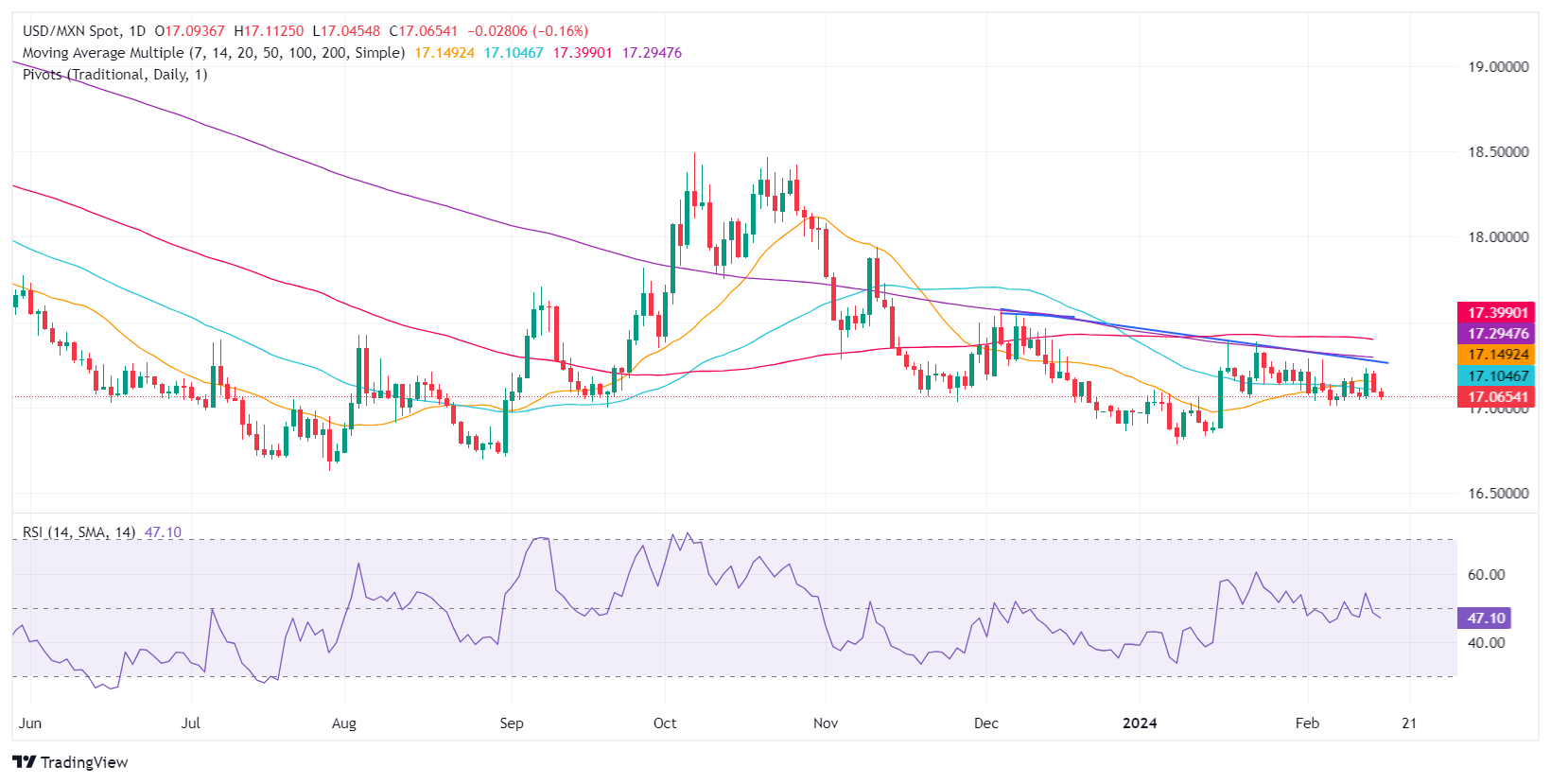Mexican Peso sees intraday gains amid mixed US economic data

- Mexican Peso appreciates against US Dollar amid weak US Retail Sales affected by high interest rates.
- Bank of Mexico reports a modest 2.2% growth in Foreign Direct Investment for the year.
- US economic outlook positive, says White House Adviser, ahead of Fed Governor Waller’s speech.
Mexican Peso (MXN) climbed against the US Dollar (USD) on Thursday following a softer retail sales report from the United States (US), an indication that higher interest rates impact consumer spending. Regarding the labor market, it remains solid after the US Bureau of Labor Statistics (BLS) announced that unemployment claims were below estimates. The USD/MXN trades at 17.04, down by 0.18%.
Mexico’s economic docket remains scarce, though the Bank of Mexico revealed that Foreign Direct Investment (FDI) registered an expansion of 2.2% by the end of last year. Nevertheless, the data suggests the growth rate slowed, failing to reach the expectations of international organizations and economists.
Across the border, White House Economic Adviser Lael Brainard said the fundamentals of the US economy seem “quite good,” and consumer purchasing power remains strong. Later, her former colleague, Fed Governor Christopher Waller, will cross the wires.
Daily digest market movers: Mexican Peso stays firm as Foreign Direct Investment grows
- Mexico’s Foreign Direct Investment came at $36 billion dollars, according to the Ministry of Economy. Although last year’s data marked a historical level, it missed estimates of $43.9 billion by the United Nations Conference on Trade and Development.
- A survey of the Bank of Mexico (Banxico) announced that 25 polled economists expected a higher figure of $38 billion.
- The US Commerce Department announced that Retail Sales experienced a greater decline than the anticipated -0.1% contraction, recording a -0.8% MoM drop attributed to winter storms. Additionally, the sales data for December was revised downward from an initial estimate of 0.6% to 0.4% MoM.
- The US Bureau of Labor Statistics (BLS) reported that for the week ending February 10, unemployment claims fell to 212K, coming in below both the prior figure and the expected 220K.
- Market players are expecting the first rate cut by the Federal Reserve at the June monetary policy meeting as they trimmed odds for March and May.
- US 10-year Treasury note yield is almost flat at 4.253%, while the US Dollar Index (DXY) dropped toward 104.41, down -0.28%.
- At its latest monetary policy decision, Banxico revised its inflation expectations to the upside for the period from Q1 to Q3 of 2024, expecting inflation to converge toward 3.5% in Q4, based on the latest monetary policy statement.
Technical analysis: Mexican Peso tests key level as USD/MXN hovers around 17.10
The USD/MXN consolidated in the 17.05-17.10 area during the last couple of days, holding near the 50-day Simple Moving Average (SMA) at 17.10. If buyers decisively break that level, the first resistance would be the psychological 17.20 area. A breach of the latter and the exotic pair could threaten the 200-day SMA at 17.29, before aiming toward the 100-day SMA at 17.39.
Conversely, if sellers step in and push prices below the 17.05 area, that would pave the way to test the 17.00 figure. Further downside is seen at last year’s low of 16.62.
USD/MXN Price Action – Daily Chart
Risk sentiment FAQs
In the world of financial jargon the two widely used terms “risk-on” and “risk off” refer to the level of risk that investors are willing to stomach during the period referenced. In a “risk-on” market, investors are optimistic about the future and more willing to buy risky assets. In a “risk-off” market investors start to ‘play it safe’ because they are worried about the future, and therefore buy less risky assets that are more certain of bringing a return, even if it is relatively modest.
Typically, during periods of “risk-on”, stock markets will rise, most commodities – except Gold – will also gain in value, since they benefit from a positive growth outlook. The currencies of nations that are heavy commodity exporters strengthen because of increased demand, and Cryptocurrencies rise. In a “risk-off” market, Bonds go up – especially major government Bonds – Gold shines, and safe-haven currencies such as the Japanese Yen, Swiss Franc and US Dollar all benefit.
The Australian Dollar (AUD), the Canadian Dollar (CAD), the New Zealand Dollar (NZD) and minor FX like the Ruble (RUB) and the South African Rand (ZAR), all tend to rise in markets that are “risk-on”. This is because the economies of these currencies are heavily reliant on commodity exports for growth, and commodities tend to rise in price during risk-on periods. This is because investors foresee greater demand for raw materials in the future due to heightened economic activity.
The major currencies that tend to rise during periods of “risk-off” are the US Dollar (USD), the Japanese Yen (JPY) and the Swiss Franc (CHF). The US Dollar, because it is the world’s reserve currency, and because in times of crisis investors buy US government debt, which is seen as safe because the largest economy in the world is unlikely to default. The Yen, from increased demand for Japanese government bonds, because a high proportion are held by domestic investors who are unlikely to dump them – even in a crisis. The Swiss Franc, because strict Swiss banking laws offer investors enhanced capital protection.
